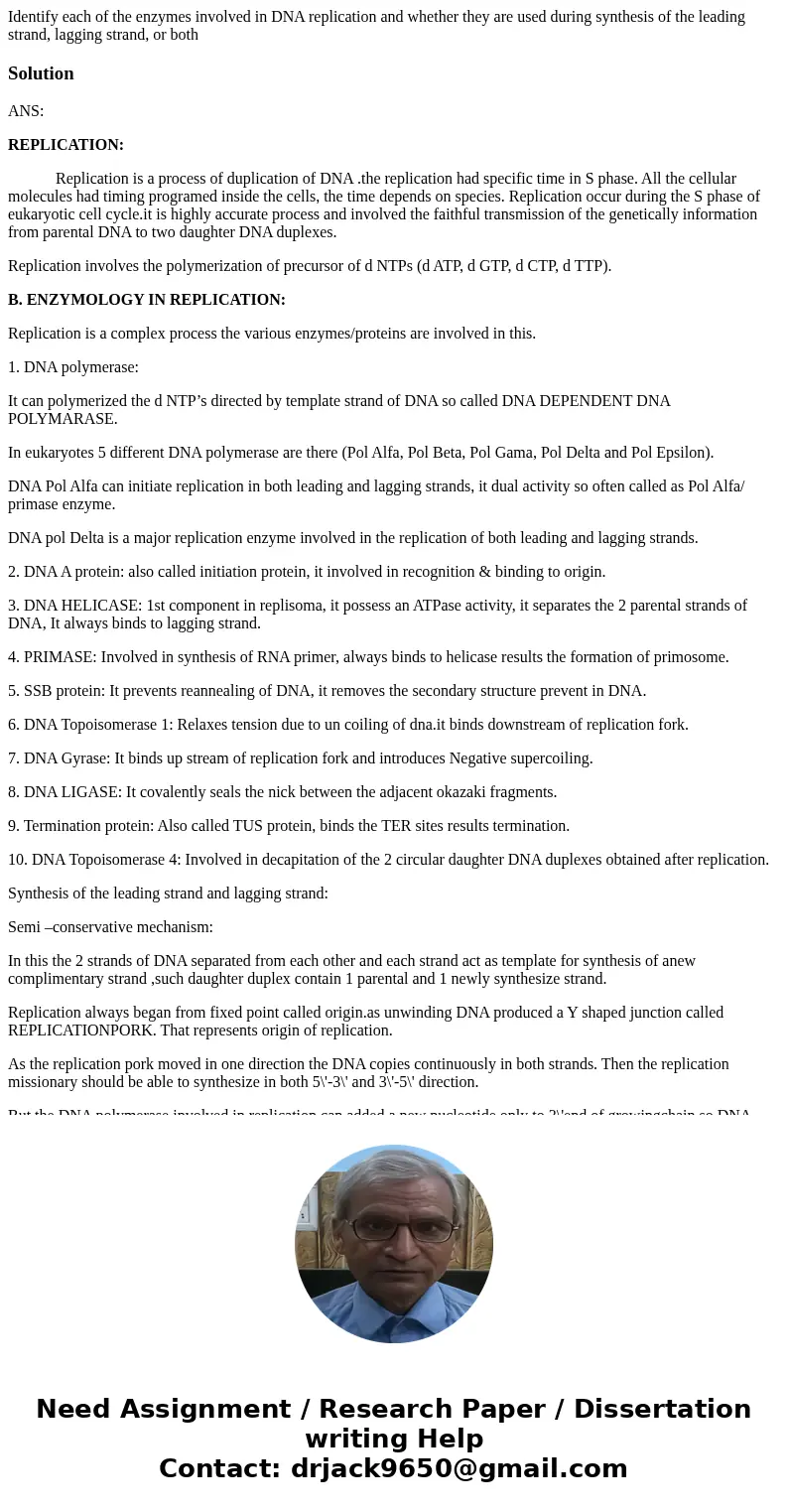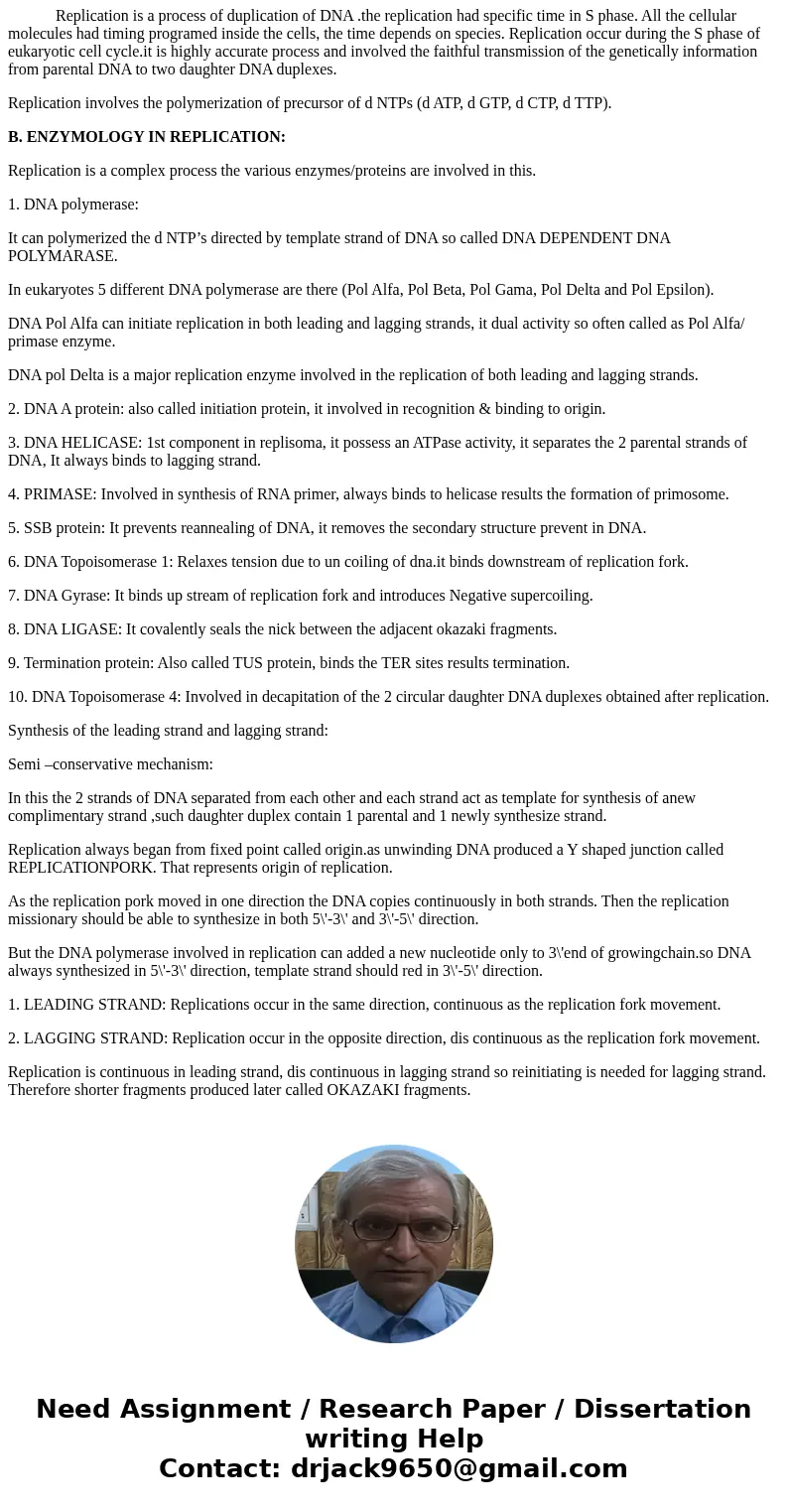Identify each of the enzymes involved in DNA replication and
Identify each of the enzymes involved in DNA replication and whether they are used during synthesis of the leading strand, lagging strand, or both
Solution
ANS:
REPLICATION:
Replication is a process of duplication of DNA .the replication had specific time in S phase. All the cellular molecules had timing programed inside the cells, the time depends on species. Replication occur during the S phase of eukaryotic cell cycle.it is highly accurate process and involved the faithful transmission of the genetically information from parental DNA to two daughter DNA duplexes.
Replication involves the polymerization of precursor of d NTPs (d ATP, d GTP, d CTP, d TTP).
B. ENZYMOLOGY IN REPLICATION:
Replication is a complex process the various enzymes/proteins are involved in this.
1. DNA polymerase:
It can polymerized the d NTP’s directed by template strand of DNA so called DNA DEPENDENT DNA POLYMARASE.
In eukaryotes 5 different DNA polymerase are there (Pol Alfa, Pol Beta, Pol Gama, Pol Delta and Pol Epsilon).
DNA Pol Alfa can initiate replication in both leading and lagging strands, it dual activity so often called as Pol Alfa/ primase enzyme.
DNA pol Delta is a major replication enzyme involved in the replication of both leading and lagging strands.
2. DNA A protein: also called initiation protein, it involved in recognition & binding to origin.
3. DNA HELICASE: 1st component in replisoma, it possess an ATPase activity, it separates the 2 parental strands of DNA, It always binds to lagging strand.
4. PRIMASE: Involved in synthesis of RNA primer, always binds to helicase results the formation of primosome.
5. SSB protein: It prevents reannealing of DNA, it removes the secondary structure prevent in DNA.
6. DNA Topoisomerase 1: Relaxes tension due to un coiling of dna.it binds downstream of replication fork.
7. DNA Gyrase: It binds up stream of replication fork and introduces Negative supercoiling.
8. DNA LIGASE: It covalently seals the nick between the adjacent okazaki fragments.
9. Termination protein: Also called TUS protein, binds the TER sites results termination.
10. DNA Topoisomerase 4: Involved in decapitation of the 2 circular daughter DNA duplexes obtained after replication.
Synthesis of the leading strand and lagging strand:
Semi –conservative mechanism:
In this the 2 strands of DNA separated from each other and each strand act as template for synthesis of anew complimentary strand ,such daughter duplex contain 1 parental and 1 newly synthesize strand.
Replication always began from fixed point called origin.as unwinding DNA produced a Y shaped junction called REPLICATIONPORK. That represents origin of replication.
As the replication pork moved in one direction the DNA copies continuously in both strands. Then the replication missionary should be able to synthesize in both 5\'-3\' and 3\'-5\' direction.
But the DNA polymerase involved in replication can added a new nucleotide only to 3\'end of growingchain.so DNA always synthesized in 5\'-3\' direction, template strand should red in 3\'-5\' direction.
1. LEADING STRAND: Replications occur in the same direction, continuous as the replication fork movement.
2. LAGGING STRAND: Replication occur in the opposite direction, dis continuous as the replication fork movement.
Replication is continuous in leading strand, dis continuous in lagging strand so reinitiating is needed for lagging strand. Therefore shorter fragments produced later called OKAZAKI fragments.


 Homework Sourse
Homework Sourse